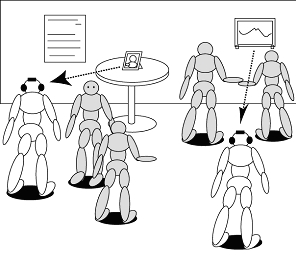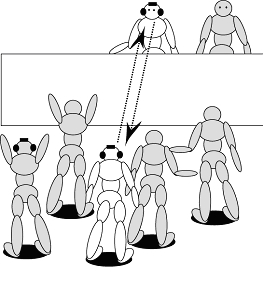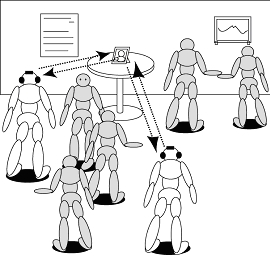
fig. 1.
Visual Resonator
|
We present Visual Resonator (VR), an auditory interface that promises to provide an interactive realization of the Cocktail Party Phenomenon. The wearer of this interface can hear a voice or auditory information only from the direction in which he/she is facing, and can send his/her voice only in the direction towards which he/she is facing. In addition, individuals who are within sight of each other can have a conversation, even if they are not close enough to talk directly, since an infrared signal is used to transmit the auditory information.
@ |
| VR is an integrated unit consisting of a microphone, headphones, infrared transmitter and receiver as shown in fig. 1. When the interface receives an infrared signal, the received signal is sent to the headphones and translated into sound. An important characteristic of this interface is that the infrared receiver is fixed to the head and has directional selectivity. Therefore, signals can only be received from the direction in which the wearer is facing and he/she can only hear a voice or other auditory information that originates from that direction. This interface can also be used to transmit speech that can be selectively received by other people. |
@
fig. 1.
|
The microphone records the voice and translates it into an infrared signal which is then transmitted like a laser beam in the direction that they are facing.
The transmitted signals can only be received by the person who is facing the speaker as in fig. 2. Thus, people who are within sight of each other can have a conversation, even though they are not close enough to talk directly. In addition, the wearer could obtain recorded auditory information from an object that he/she is looking at as in fig. 3, since the infrared transmitter can be attached to an object, instead of to a person. By combining these two approaches, speech that has been transmitted by an individual in the direction he/she is facing could be relayed by an
infrared transmission unit at the object and then received by other people, who are also viewing the same object. Thus, people looking at the same object could communicate with each other through this interface as in fig. 4, as if the voice signal were reflected off the object. An interface of this kind would facilitate communication between people who are looking at the same object and have shared interests.
@ |

Scenario 1: Head-oriented information presentation
|
Junji visits an art gallery and borrows VR at the entrance. A lot of visitors are crowded round a famous painting. Junji cannot get a close look, but when he looks at it from a distance, he is able to hear a commentary about the work of art. An infrared transmitter has been attached to the work of art and VR receives the signal, when Junji looks at it. Although various information presentation devices have been introduced in museum exhibitions, our interface would allow visitors to access a commentary about an exhibit merely by facing it, rather than by pushing buttons. Wearers would automatically hear auditory information from whatever they were looking at and whatever their focus of interest was. In addition,
the sound source could be attached to any kind of object, such as clothes or even moving objects
. |

Scenario 2: Interactive Cocktail Party
situation
|
Junji is attending a dance party. Several VRs are delivered to the attendees including Junji. It is very crowded on the dance floor and techno music is playing at full blast. He canft move or make conversation. He notices that the DJ is an old friend. They catch one anotherfs eye and turn their heads towards each other. Junji speaks to the DJ gHello! Is that you John?h DJ, John answers gYes, Junji!h They are able to talk, even in a loud music environment, because both are wearing VR and VR uses infrared signals to transmit auditory information. Then Junji requests his favorite song through
VR.
@ |

Scenario3: Conversation through shared interests
|
Junji is pottering around a gallery, when he sees what he considers to be one of the best works and suddenly picks up another personfs voice, gWow, this is great!h The voice has come from another visitor, who is also wearing VR. This visitor is standing on the other side of the gallery. Through VR, the two of them are able to exchange opinions quietly (without disturbing other visitors). Then, they are able to have a direct conversation about the artwork once they are outside the gallery. The recorded voice was relayed by the infrared transmission unit at the artwork, and then was received by other people, who are looking at it. Thus
this interface can promote communication between people with the same interests.
Paper
in CHI2006 |
@
@
contact Junji Watanabe: w_junji(at)hotmail.com